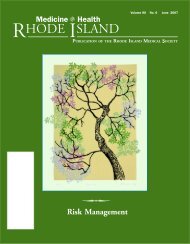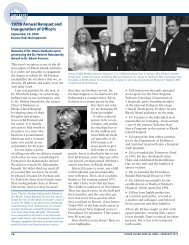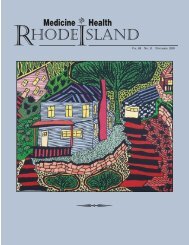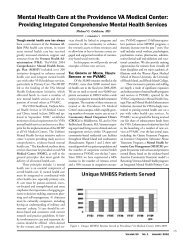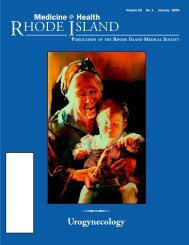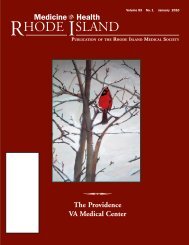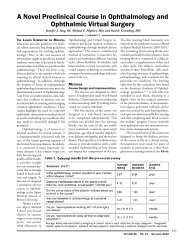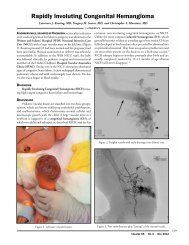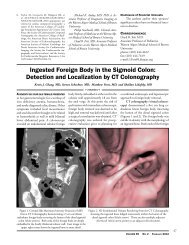Hyperuricemia & Gout - Rhode Island Medical Society
Hyperuricemia & Gout - Rhode Island Medical Society
Hyperuricemia & Gout - Rhode Island Medical Society
You also want an ePaper? Increase the reach of your titles
YUMPU automatically turns print PDFs into web optimized ePapers that Google loves.
THE WARREN ALPERT MEDICAL SCHOOL<br />
OF BROWN UNIVERSITY<br />
Division of Geriatrics<br />
Department of Medicine<br />
GERIATRICS FOR THE<br />
PRACTICING PHYSICIAN<br />
Asymptomatic Versus Symptomatic Urinary Tract Infections<br />
In Long-Term-Care-Facility Residents<br />
Porpon Rotjanapan, MD, and David Dosa, MD, MPH<br />
Quality Partners of RI<br />
EDITED BY ANA TUYA FULTON, MD<br />
You are in your office seeing patients when a nurse calls<br />
from the nursing home to report the urinalysis results of Mrs. X.<br />
Mrs. X, 75 years-old, with mild Alzheimer’s dementia, was admitted<br />
to the facility for rehabilitation and low back pain control<br />
after two falls. Her medical history also includes hypertension,<br />
hyperlipidemia, chronic obstructive pulmonary disease<br />
(COPD), osteoporosis, and two new vertebral compression fractures.<br />
Yesterday the nursing staff noticed foul smelling urine and<br />
contacted your covering physician for an order to obtain a clean<br />
catch urine. Currently, Mr.s X is afebrile, without any specific<br />
complaints. She takes oxycodone and acetaminophen for pain<br />
control, donepezil for her Alzheimer’s, a bisphosphonate for her<br />
osteoporosis, and an albuterol inhaler for her COPD. She has<br />
no medication allergies. The urinalysis reveals 20-30 WBC/ml,<br />
5-10 RBC /ml, and numerous bacteria. A urine culture has been<br />
sent but results are unavailable. The nurse asks whether you would<br />
like to start antibiotics.<br />
Urinary tract infections (UTIs) are the most common<br />
bacterial infection in older populations, both in the community<br />
and in the nursing home (NH). 1 UTIs are the most common<br />
reason for antimicrobial prescriptions in NHs, and are<br />
responsible for the initiation of 20-60% of systemic antimicrobial<br />
courses in long term care residents. 2 Fifty percent of<br />
female and 40% of male residents have been reported to have<br />
a UTI at one time or another. Nursing home residents are at<br />
particular risk for UTIs. Risk factors for infection in this population<br />
include immobility, which leads to incomplete bladder<br />
emptying; poor hygiene, which favors bacterial growth; incontinence;<br />
and age-associated physiological changes, such<br />
as a decline in the effectiveness of immune function, loss of<br />
estrogen effect on genitourinary mucosa, and changes in colonizing<br />
flora. 3-5<br />
Despite the high prevalence of UTIs in the NH, most<br />
patients are clinically asymptomatic. Numerous organizations<br />
(e.g., the American <strong>Medical</strong> Director’s Association, The Infectious<br />
Disease <strong>Society</strong> of America) have advocated against<br />
the treatment of asymptomatic bacteriuria for a number of<br />
reasons. First, the presence of asymptomatic bacteriuria in<br />
the older patient - including the diabetic - does not predict<br />
future UTI or mortality. 2,6,7 Furthermore, treatment of asymptomatic<br />
bacteriuria does not prevent recolonization or<br />
reduce the risk of developing symptomatic UTI. On the other<br />
hand, unnecessary treatment of asymptomatic UTIs has been<br />
correlated with increased resistance in colonizing bacteria.<br />
Are there criteria that I can use to determine if my patient<br />
has asymptomatic or symptomatic bacteriuria?<br />
The Department of Health and Human Services and the<br />
Centers for Medicare and Medicaid Services issue yearly guidelines<br />
for NHs that state that only residents meeting the McGeer<br />
Criteria should be treated for UTI. 8,9 Urine culture results are<br />
not required by these criteria to make a decision on empirical<br />
coverage. The McGeer criteria for NH residents without an<br />
indwelling catheter state that 3 of the following criteria must<br />
be met to identify a UTI: (1) a temperature of 38 C (100.4 F)<br />
or higher; (2) new or increased burning sensation on urination,<br />
frequency of urination, or urgency of urination; (3) new<br />
flank or suprapubic pain or tenderness; (4) change in character<br />
of urine; and (5) worsening of mental or functional status.<br />
Other guidelines for UTIs proposed by Loeb et al. can also be<br />
useful as minimum criteria necessary for empirical antibiotic<br />
therapy. 10 For nursing home residents without an indwelling<br />
catheter, the Loeb criteria recommend empirical coverage in<br />
the setting of: acute dysuria alone or fever (a temperature of<br />
greater than 37.9 C (100 F) or an increase of 1.5 C (2.4 F)<br />
above baseline temperature) plus at least 1 of the following<br />
symptoms: new or worsening urgency or frequency of urination,<br />
suprapubic pain, gross hematuria, costovertebral angle<br />
tenderness, or urinary incontinence. 11,12<br />
You decide not to start antimicrobial therapy for Mrs. X,<br />
since her clinical presentation does not meet either the McGeer or<br />
Loeb criteria. Three months later, Mrs. X develops dysuria and a<br />
fever to 101. Examination reveals tachycardia and suprapubic<br />
tenderness. Her urinalysis reveals 30 WBC/ml, 3-5 RBC /ml, 1+<br />
squamous epithelial cells. Given her overt symptoms, you decide to<br />
start empiric antibiotic,s pending results from a urine culture.<br />
Your patient has no known drug allergies. Which antibiotic is the<br />
best option?<br />
EMPIRICAL TREATMENT FOR SYMPTOMATIC UTIS<br />
The treatment of a lower tract UTI can usually be managed<br />
in the NH. Choices for empiric regimens should always<br />
be made with the knowledge of the individual nursing home’s<br />
antibiogram and resistance pattern, and resistance patterns of<br />
the usual colonizing flora. In most nursing homes, the medical<br />
director leads the infection control team and assembles an<br />
antibiogram for distribution to other clinicians practicing there.<br />
If one is not available, there are several general recommendations.<br />
VOLUME 92 NO. 11 NOVEMBER 2009<br />
377



